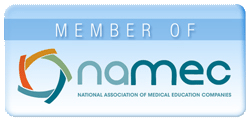|
| Faculty | |
| Statement of Need | |
| Financial Support | |
| Credit Information | |
Featured Article: The impact of obstructive sleep apnea and daytime sleepiness on work limitation
neuroscienceCME Journal Club
Premiere Date: Monday, January 14, 2008 | Thomas Roth, PhD Chief, Division Head Sleep Disorders and Research Center Henry Ford Hospital Detroit, MI |
 | Najib Ayas, MD, MPH (Faculty) Associate Professor of Medicine University of British Columbia, Respiratory Division Centre for Clinical Epidemiology and Evaluation, Vancouver Coastal Health Vancouver, BC |
As the knowledge base within the neurosciences expands exponentially, it becomes a challenge to keep pace and to know
where to focus precious time in search of the most clinically relevant literature.
neuroscienceCME Journal Club was designed for clinicians who have made this commitment to staying current. Are you
seeking a trusted resource for identifying and distilling the most critical information from the literature? Each month, the
neuroscienceCME Journal Club will evaluate emerging literature and present it in an engaging audioconference + webcast
format full of valuable takeaway points that can be applied directly to clinical practice. Ask the authors and experts about
the details of key articles and participate in a peer-to-peer discussion on how to translate the evidence into practice
improvements.
January 2008:
Mulgrew AT, Ryan CF, Fleetham JA, Cheema R, Fox N, Koehoorn M, Fitzgerald JM, Marra C, Ayas NT. The impact of obstructive sleep apnea and daytime sleepiness on work limitation. Sleep Med 2007;9:42-53.
View Abstract
Summary:
In contrast to many other chronic medical disorders, many patients with obstructive sleep apnea (OSA) participate in the work force. We know that OSA results in daytime sleepiness, reduces vigilance, and negatively affects quality of life; we would thus expect decrements in work productivity associated with OSA. However, the impact of OSA and sleepiness on work performance has not been well-studied.
Methods:
We performed a cross-sectional study of 428 patients referred for an overnight polysomnogram to exclude OSA at the University of British Columbia Sleep Disorders Program. These patients completed the Epworth Sleepiness Scale (ESS), the Work Limitations Questionnaire (WLQ), and an occupational survey. The WLQ is a validated measure of work limitation, and assesses degree of work limitation in four domains (time management, physical functioning, mental-interpersonal interactions, and overall output).
Results:
Their mean age ± (standard deviation) was 49 ± 12 years, mean apnea hypopnea index (AHI) was 21 ± 22 events/hr of sleep, and mean ESS score was 10 ± 5. There was no significant relationship between OSA severity and the 4 dimensions of work limitation. However, ESS score was strongly associated with three of the four dimensions of work limitation. That is, patients with an ESS score of < 5 had much less work limitation compared to those with an ESS score > 18 in terms of time management (limited 19.7% of the time vs. 38.6 % of the time, p < .001); mental-interpersonal relationships (15.5% vs. 36.0%, p < .001); and work output (16.8% vs. 36.0%; p < .001). Follow-up of 33 patients with OSA who used continuous positive airway pressure (CPAP) therapy occurred after two years; they showed significant improvements in time management (26% vs. 9%, p = .0005), mental-interpersonal relationships (16% vs. 11.0%, p = .014), and work output (18% vs. 10%; p < .009).
Conclusion:
Excessive sleepiness is associated with increased work limitation in a population referred for suspected OSA. CPAP may improve work performance in patients with OSA. Sleep disorders may be a potential treatable cause of low work productivity.
CME Outfitters, LLC, gratefully acknowledges an independent educational grant from Cephalon, Inc., in support of this complimentary 30-minute activity.
CE credit will not be offered for this activity.
Najib Ayas, MD, MPH
Dr. Najib Ayas is currently an Associate Professor of Medicine at the University of British Columbia. He graduated with distinction from the University of Alberta in 1992. He completed an Internal Medicine Residency at the Mayo Clinic in 1996, and post-graduate training in Respiratory, Critical Care, and Sleep Medicine at Brigham and Women’s Hospital/Harvard Medical School in 2000. He was on staff at Brigham and Women’s Hospital for two years, and then joined the Sleep Disorders Program at the University of British Columbia in September 2002. He also has a Masters Degree in Public Health from the Harvard School of Public Health. His research focuses on the public health and safety consequences of sleep apnea and sleep deprivation. His work has been published in a variety of medical journals including the New England Journal of Medicine, Journal of the American Medical Association, American Journal of Respiratory and Critical Care Medicine, Chest, Sleep, Lung, Diabetes Care, Journal of Clinical Endocrinology and Metabolism, Sleep Medicine, Journal of Clinical Sleep Medicine, Thorax, Archives of Internal Medicine, Mayo Clinic Proceedings, Annals of Internal Medicine, and Current Opinion in Pulmonary Medicine.
Thomas Roth, PhD
Dr. Roth is a Clinical Professor in the Department of Psychiatry at the University of Michigan College of Medicine, Ann Arbor, and Director of the Sleep Disorders and Research Center at Henry Ford Hospital, Detroit, Michigan. He received his PhD from the University of Cincinnati, Cincinnati, Ohio. He is currently Chairman of the World Health Organization (WHO) worldwide project on sleep and health and has served on several WHO national and international committees. Formerly, Dr. Roth served as Chair of the National Institutes of Health's National Center of Sleep Disorders Research. He is a past president of the American Academy of Sleep Medicine, the National Sleep Foundation, and the Sleep Research Society. He has also chaired committees of the Association of Professional Sleep Societies, the American Academy of Sleep Medicine, and the World Federation of Sleep Research Society. Dr. Roth's research has included sleep loss, sleep fragmentation, sleep pathologies, and the effects of pharmacologic agents on sleep-wake function.
Disclosure Declaration
It is the policy of CME Outfitters, LLC, to ensure independence, balance, objectivity, and scientific rigor and integrity in all its CE activities. Faculty must disclose to the participants any significant relationships with commercial companies whose products or devices may be mentioned in faculty presentations, or with the commercial supporter of this CE activity. CME Outfitters, LLC, has evaluated, identified, and attempted to resolve any potential conflicts of interest through a rigorous content validation procedure, use of evidence-based data/research, and a multidisciplinary peer review process. The following information is for participant information only. It is not assumed that these relationships will have a negative impact on the presentations.
Dr. Ayas has disclosed that he receives research support from Respironics, Inc.
Dr. Roth has disclosed that he receives grants from Cephalon, Inc., GlaxoSmithKline, Neurocrine Biosciences, Inc., Pfizer Inc., sanofi-aventis, Schering-Plough Corporation, Sepracor Inc., Somaxon Pharmaceuticals, Inc., Syrex, Takeda Pharmaceuticals North America, Inc., TransOral Pharmaceuticals, Inc., Wyeth Pharmaceuticals, and Xenoport, Inc. He serves as a consultant to Abbott Laboratories, Acadia Pharmaceuticals, Inc., Acoglix, Actelion, Alkermes, Inc., ALZA Corporation, Ancil, Arena Pharmaceuticals, AstraZeneca Pharmaceuticals, Bristol-Myers Squibb Company, Cephalon, Inc., Cypress Bioscience, Inc., DOV Pharmaceutical Inc., Elan Pharmaceuticals, Inc., Eli Lilly and Company, Evotec Inc., Forest Pharmaceuticals, Inc., GlaxoSmithKline, Hypnion Inc., H. Lundbeck A/S, Hoffmann-La Roche Inc., Johnson & Johnson, King Pharmaceuticals, Inc., McNeil, MediciNova, Inc., Merck & Co., Inc., Neurim Pharmaceuticals, Neurocrine Biosciences, Inc., Neurogen Corporation, Novartis Pharmaceuticals Corporation, Orexo AB, Organon Pharmaceuticals USA, Inc., Orginer, Prestwick Pharmaceuticals, Inc., Proctor & Gamble, Pfizer Inc., Purdue Pharma LP, Resteva, sanofi-aventis, Schering-Plough Corporation, Sepracor Inc., Servier, Shire Pharmaceuticals, Somaxon Pharmaceuticals, Inc., Syrex, Takeda North America Pharmaceuticals, Inc., TransOral Pharmaceuticals, Inc., VANDA Pharmaceuticals, VivoMetrics, Wyeth Pharmaceuticals, XenoPort, Inc., and Yamanouchi Pharma America, Inc. He is on the speakers bureaus of sanofi-aventis and Takeda Pharmaceuticals North America, Inc.
Unlabeled Use Disclosure
Faculty of this CE activity may include discussions of products or devices that are not currently labeled for use by the FDA. The faculty have been informed of their responsibility to disclose to the audience if they will be discussing off-label or investigational uses (any uses not approved by the FDA) of products or devices.
CME Outfitters, LLC, the faculty, and Cephalon, Inc., do not endorse the use of any product outside of the FDA labeled indications. Medical professionals should not utilize the procedures, products, or diagnosis techniques discussed during this activity without evaluation of their patient for contraindications or dangers of use.
Questions about this activity? Call us at 877.CME.PROS (877.263.7767).
JC-001-011408-05



